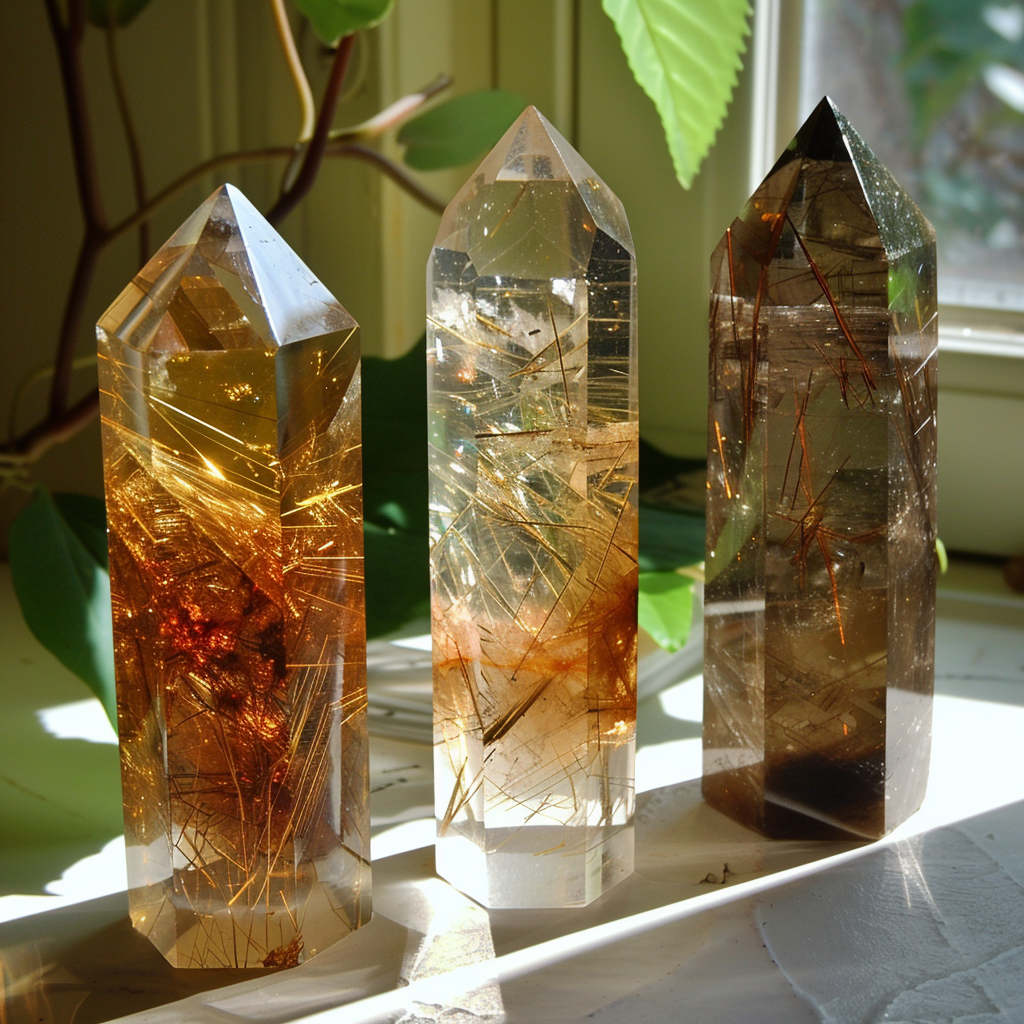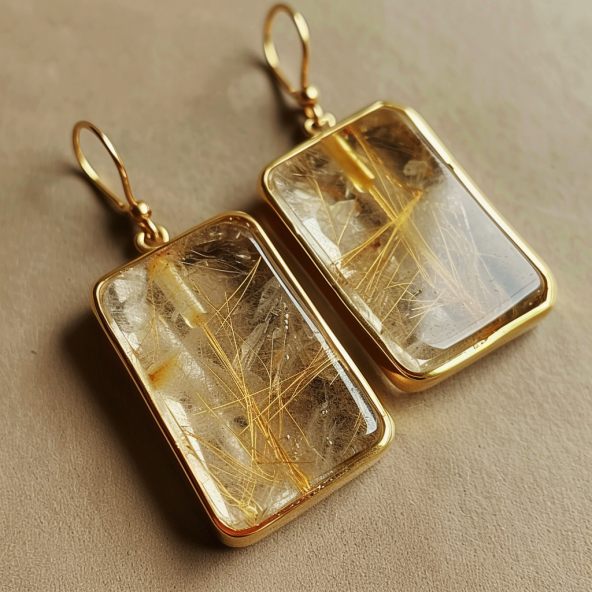4Cs Work in Rutilated Quartz
The “4Cs Work in Rutilated Quartz” offers a comprehensive framework for evaluating this captivating gemstone’s quality and value. The 4Cs—Clarity, Cut, Carat, and Color—play a vital role in understanding rutilated quartz and its unique appeal. Unlike traditional gemstones, where clarity often equates to flawlessness, the inclusions in rutilated quartz are its most defining and desirable feature, making clarity an entirely different aspect of evaluation. The “4Cs Work in Rutilated Quartz” also highlights the importance of cut, which showcases the mesmerizing needle like rutile inclusions, carat weight, which determines the stone’s size and impact, and color, which varies based on the hues of the rutile inclusions. Understanding how the 4Cs work in rutilated quartz allows buyers to appreciate its natural artistry while selecting the perfect stone for their needs.

1. Color of Rutilated Quartz
The color of Rutilated Quartz is determined by the hue of both the quartz base and the rutile inclusions. Typically, the quartz is colorless, allowing the rutile needles to shine through clearly. However, Rutilated Quartz can also come in smoky or amethyst varieties, with smoky quartz ranging from light to dark brown, and amethyst quartz presenting a pale to rich purple color.
The rutile inclusions in Rutilated Quartz can vary significantly in color, ranging from golden yellow, which is the most common, to copper red, silver, or even black. The most prized specimens are often those with vivid golden or copper rutile needles that contrast strikingly against a transparent quartz base. The interplay between the color of the rutile needles and the quartz body determines the gemstone’s overall visual appeal and its desirability.
When selecting Rutilated Quartz, consider the overall harmony of the colors. Bright, well-formed golden rutile needles against a clear quartz base are usually preferred for jewelry due to their luminous and luxurious look.
2. Clarity of Rutilated Quartz
Clarity in Rutilated Quartz is different from traditional gemstones, where inclusions often decrease the value. Here, the rutile inclusions are what make the gemstone unique and beautiful. Clarity refers to the transparency of the quartz itself and the arrangement of the rutile inclusions.
- Quartz Clarity: A high-quality Rutilated Quartz typically has a clear quartz base that allows the rutile needles to be visible without obstruction. However, there are also stones with smoky or slightly cloudy quartz that provide a dramatic backdrop for the needles.
- Rutile Inclusion Clarity: The inclusions can be fine and delicate, like hair, or thick and striking, resembling needles. Stones with symmetrical, prominent inclusions that form an interesting pattern are considered the most attractive. The clarity of the rutile is also important—lustrous, shiny needles enhance the gemstone’s appeal, while dull or poorly-formed needles may be less desirable.
Ultimately, clarity in Rutilated Quartz is not about the absence of inclusions but about the beauty and aesthetic arrangement of those inclusions. Some may prefer densely packed inclusions, while others seek delicate, thread-like patterns—it’s a matter of personal taste.
3. Cut of Rutilated Quartz
The cut of Rutilated Quartz plays a vital role in showcasing the unique rutile inclusions and ensuring that the stone has an optimal play of light. Rutilated Quartz is usually faceted or cut into cabochons, depending on the clarity of the quartz and the density of the rutile inclusions.
- Faceted Cut: Faceting Rutilated Quartz helps enhance the brilliance and sparkle of the gemstone, especially when the quartz is highly transparent. A well-executed faceted cut can create angles that reflect light through the rutile needles, adding extra depth and dimension to the stone.
- Cabochon Cut: For Rutilated Quartz with dense or dramatic rutile patterns, cabochon cuts are often preferred. A smooth, polished surface showcases the inclusions without interference, giving the viewer a clear, unbroken look at the internal rutile patterns.
The cutter’s skill is especially important when cutting Rutilated Quartz. The goal is to position the rutile inclusions to maximize their visual impact while retaining as much of the original crystal as possible. A well-cut stone will have evenly distributed inclusions, with a balanced composition that highlights the unique character of the gemstone.
4. Carat Weight of Rutilated Quartz
Carat weight refers to the size of the gemstone, and with Rutilated Quartz, larger specimens are often more desirable due to the visibility of the inclusions. The larger the stone, the more intricate and detailed the rutile needles appear, allowing the gemstone’s natural beauty to shine through. Since Rutilated Quartz is a relatively common mineral, it is possible to find impressive carat weights at more accessible price points compared to rarer gemstones.
Rutilated Quartz can be found in a wide range of sizes, from small gemstones suitable for rings and earrings to large pieces ideal for statement necklaces or pendants. When selecting a larger carat weight, consider how the size affects the visibility and impact of the rutile inclusions—sometimes, a larger stone may reveal complex patterns that smaller specimens cannot display.
Conclusion
The 4Cs—Color, Clarity, Cut, and Carat Weight—are essential in evaluating Rutilated Quartz, but they have a unique interpretation compared to other gemstones. The interplay of golden or copper needles with a transparent or smoky quartz base creates a stunning visual effect that is both captivating and one-of-a-kind. The beauty of Rutilated Quartz lies in its inclusions, turning what might be considered imperfections in other stones into elements of wonder and distinction.

Whether you’re drawn to the vivid colors of the rutile needles, the clarity and arrangement of the inclusions, the skill of the cut, or the size that enhances the stone’s visual appeal, Rutilated Quartz offers something for everyone. By understanding the 4Cs in the context of Rutilated Quartz, you can better appreciate its unique beauty and choose a stone that resonates with your personal style and aesthetic preferences.
When selecting a piece of Rutilated Quartz jewelry or adding to your collection, keep these 4Cs in mind to find a gemstone that truly speaks to you, capturing both the beauty of nature and the skill of human craftsmanship.
Step into the mesmerizing world of gemstones with our fascinating Introduction to Rutilated Quartz.
